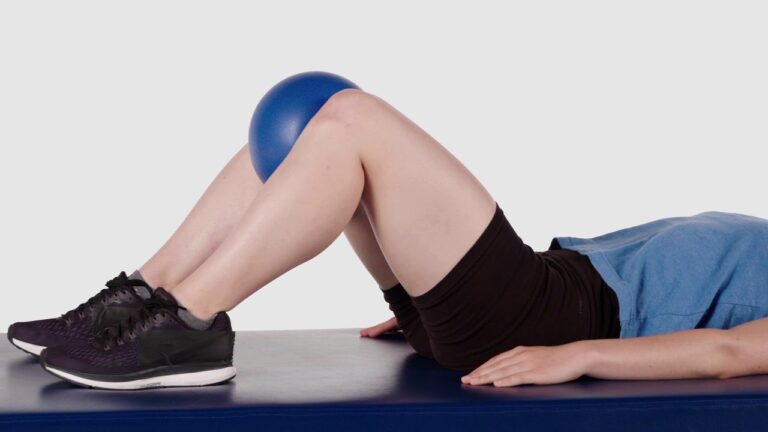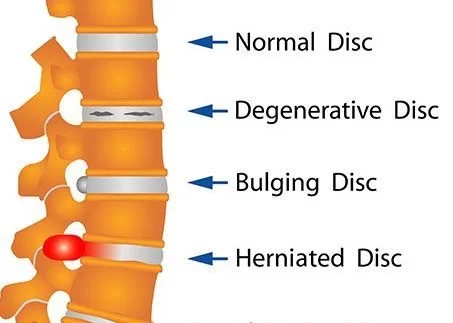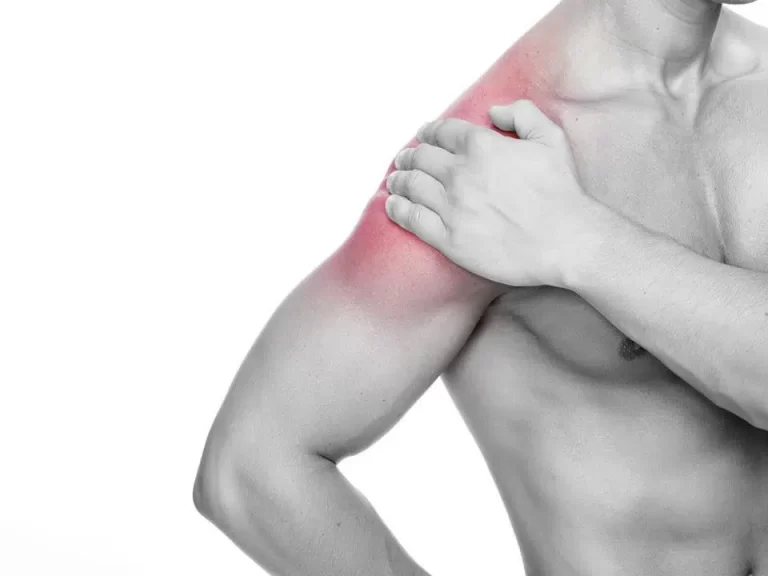Deltoid muscle strengthening exercise
Table of Contents
Introduction
- Deltoid muscle-strengthening exercise is an essential exercise to make the shoulder more powerful to perform all daily activities easily also has many health benefits & decreases the risk of injury.
What is a Deltoid muscle-strengthening exercise?
- The deltoid muscle plays an essential role in shoulder motions, and this is quintessential that the patient trains the deltoid muscle with a highly targeted workout regime. The deltoid muscle has three heads anterior, medial, as well as posterior. The anterior deltoid helps to move the arm forward. They connect to the clavicle. The patient uses the front deltoids if the patient reaches for the object on a shelf.
- Lateral deltoids: Side deltoids that help to move the arm out to the side, as well as up & down, The primary action of posterior deltoids is external rotation, extension, & horizontal abduction,
- Strengthening those deltoids will automatically enhance the strength & ability to do a ton of different exercises. Also, strengthening the shoulders assists in getting better posture, so the patient look confident and feels sexier and prevents injury.
- Take time & think about how many things the patient carries from point A to point B in daily life. Groceries up the stairs, the
- backpack to the office. Strong arms are essential to perform all activities but if the patient is sleeping on the shoulders, he is making a big mistake.
- Another good reason for the deltoid workout is injury prevention is clutch, especially when this comes to being in tip-top shape for racing.
- Oddly, the workout schedule includes a day or two dedicated to the upper body. The patient strengthens the triceps, biceps, & of
- course the shoulders. The patient does not want to forget about the deltoids, each of which consists of three distinct heads: the
- anterior (frontal), lateral (side), & posterior (rear).
- Males & females both tend to have developed anterior deltoid muscles by doing everyday activities, such as lifting & pressing objects.
- But most individuals have pretty weak middle as well as back deltoids since we rarely lift objects to the side or behind us in daily life, therefore, to build fully defined shoulders, the patient wants to include some targeted deltoid exercises in the workout routine. Here are some of the best deltoid exercises to help the patient get bigger & stronger.
Health benefits of Deltoid strengthening exercise
- Shoulder strength exercises may promote healthy motion patterns & improve posture as well as muscle function.
- Performing these exercises regularly can assist to treat & prevent shoulder injuries and allow the patient to move with greater ease and strength.
- The deltoid exercise strengthens the shoulders, upper back, & upper arms.
- This helps to improve posture and is beneficial for people who sit or do forward-bending motions often.
Types of Deltoid strengthening exercises
Anterior Deltoid Raise
- Benefits: One of the best anterior deltoid exercises, it targets the muscle’s anterior head of a deltoid. It helps to build the strength needed to lift objects in front of you.
- How to do this strengthening exercise:
- For this exercise, the patient has to Stand with the feet hip-width apart and grab the dumbbell in both hands with the arms by the sides.
- The arms should be straight, slowly lift a dumbbell directly in front of you to shoulder height with the palms facing each other.
- Gradually Lower back down to the starting position & repeat.
- Do ten to twenty repetitions of one to two sets.
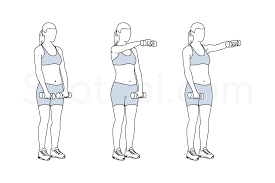
Callahan Press
- Benefits: This exercise hits all three heads of the deltoids, and the Callahan press helps with full-shoulder development.
- How to do this strengthening exercise:
- For this exercise, the patient has to stand with feet hip-width apart and grab the dumbbell in both hands.
- Raise the arms out to the sides with the elbows flexed up to 90 degrees.
- The upper arms should be in line with the shoulder joint, & the hands should point toward the roof. It is the embarking position.
- Move the forearms in front of you & turn the palms inside toward the face.
- Then reverse the motion to come back to the starting position.
- Plow the weights directly beyond the shoulders, & then reverse the motion to substitute to the starting position.
- That is one repetition.
- Do ten to twenty repetitions of one to two sets.

Standing Arnold Press
- Benefits: It moves to target all 3 heads of the deltoid muscle, & this recruits the triceps while the pressing movement.
- How to do this strengthening exercise:
- The patient has to Stand with the feet hip-width apart, grab the dumbbell in both hands just under the chin, palms facing you.
- Press the dumbbells overhead by you and rotate the palms out until they are body away from you.
- Pause at the top, then lower the dumbbells back down to starting, rotating the palms back toward you.
- Do ten to twenty repetitions of one to two sets.
Jerk Press
- Benefits: The jerk press assists to build strength & power, and the patient uses the deltoids along with the trapezius and triceps as well.
- How to do this strengthening:
- For this exercise, the patient has to stand with the feet hip-width apart and grab a pair of dumbbells in front of the shoulders, palms facing each other. It is the starting position.
- In one explosive movement, press the weights overhead during jumping the right foot forward, & left foot back so you land in a high lunge.
- Step the front foot back to the embarking position, bringing the weights back to shoulder height.
- Do ten to twenty repetitions of one to two sets.
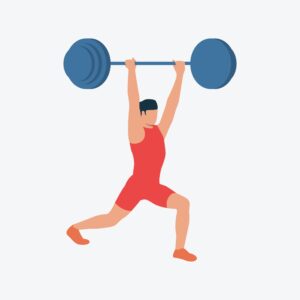
Hammer Curl to Press
- Benefits: Not only does this combination motion work the deltoids, but this also utilizes many other muscles in the upper limb, including the forearms, biceps, & triceps.
- How to do this strengthening exercise:
- For this exercise the patient has to Stand with the feet hip-width apart, grab the dumbbell in both hands with the arms at the sides, palms facing each other.
- The elbows should be tucked into the sides, and curl dumbbells up towards the shoulders without moving the upper arms.
- Press the dumbbells above the head until the arms are extended, and the palms should be facing each other.
- Reduce the weights back down to the shoulders, then lower the arms all the way linear down to the sides.
- Do ten to twenty repetitions of one to two sets.
Bent-Over Lateral Raise (Reverse Fly)
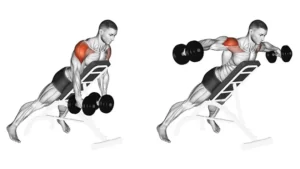
- Benefits: This total-body move employs the quadriceps, glutes, all 3 parts of the deltoid muscles, & the obliques.
- How to do this strengthening exercise:
- For this exercise the patient has to stand with the legs wide, toes turned out 45 to 50 degrees, and grab one dumbbell with both hands in front of the chest. It is the starting position.
- Push the hips back as you slowly lower into a sumo squat, the back should be straight.
- Push through the heels to extend the legs.
- Starting on the right, circle a dumbbell around the head, rotating this around & back to the right.
- As the patient brings the dumbbell around to the front, continue the motion & pivot both feet to the right.
- Flexed both knees into the lunge & straighten the arms to slowly lower a dumbbell in front of the front knee.
- Extend the legs & pivot back to the starting position, and move the dumbbell back in front of the chest. Repeat on the left side.
- Do ten to twenty repetitions on both sides for one to two sets.
Seated EZ Bar Underhand Press
- Benefits: This move can seem simple, but the patient is working the anterior head of the deltoid, the triceps, & the serratus anterior (the muscle under the shoulder blade that covers the ribs), all to build strength and improve shoulder stability.
- How to do this strengthening exercise:
- Adjust an incline bench so the back is vertical & sit on the seat.
- Load an EZ Bar & hold this in the middle with an underhand grip. Flexed the arms to bring the bar underneath the chin.
- Press a bar directly overhead until the arms are extended.
- Gradually bring the barbell back down right below the chin, & repeat.
- Do ten to twenty repetitions of two to three sets.
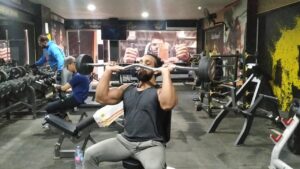
Upright Row to Hip Fly
- Benefits: This two-part move targets the medial heads of the deltoids, the trapezius, & the biceps, all of which assist build pulling strength.
- How to do this strengthening exercise:
- For this exercise the patient has to Stand with the feet hip-width apart, and grab a pair of dumbbells in front of the thighs, palms facing you.
- The chest should be up & core engaged, lift the dumbbells to the chin in an upright row.
- The elbows should not raise above shoulder height.
- Bring the arms down to the sides, flex the knees, push the hips back, & hinge forward into the flat back.
- Let the arms hang straight with the palms facing back.
- The arm should be straight & shoulder blades pulled back, raise the dumbbells behind you.
- Lower the arms & repeat.
- Do ten to twenty repetitions of one to two sets.
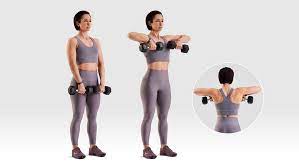
Dumbbell Lateral Raise
- How to do this strengthening exercise:
- This is a very effective exercise that targets the anterior & medial deltoid muscles. Additionally, the exercise targets the upper back, trapezius, & core.
- For this practice Stand straight with feet planted shoulder-width apart. Grasp dumbbells in both hands with the pronated grip.
- Slowly raise the arms in an arc to the sides until the dumbbells are in line with the shoulders. Do not flex the elbows & ensure that the arms are parallel to the ground.
- Stop for a moment & return to the embarking position.
- Do ten to twelve repetitions of one to two sets.
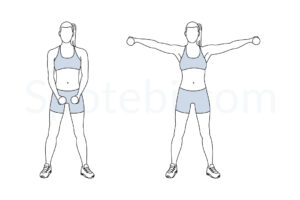
Decline Push-Up
- How to do this strengthening exercise:
- The push-up is traditionally known for building the strength of pectoral muscles in the chest. The decline push-up is an advanced variation of the standard push-up that works the anterior deltoids with greater intensity.
- For this exercise, the patient has to Lie on the floor in a prone position with the hands planted around shoulder-width.
- Place the feet on an elevated platform such that the body forms an acute angle with the floor.
- The elbows should be bent, & the torso should only be centimeters away from the floor.
- Elevate the upper limb until the arms are fully straightened & perpendicular to the ground. Hold at that point for two seconds then come back to the starting position.
- Do ten to twenty repetitions of one to two sets.
Walking Plank

- How to do this strengthening exercise:
- For this exercise, the patient has to start with the high plank position.
- Bracing through the core, move the left hand & left foot out six to seven inches.
- Bring the right foot & right hand to meet it.
- Gradually move left for 15 to 20 seconds, then come back to the starting position to complete the set.
Face Pull
- How to do this strengthening exercise:
- Kneel with the left foot forward in front of the cable machine.
- Grab the handles by the palms facing in & pull them toward the face, drawing the hands apart.
- Hold at that point for a couple of seconds, then come back to the embarking position.
- Do ten to twenty repetitions of one to two sets.

Side-lying external rotation
- How to do this strengthening exercise:
- The side-lying external rotation focuses on the outer motion that the posterior deltoid performs. This also works on some rotator cuff muscles (infraspinatus & teres minor).
- For this exercise, a patient has to lie on the right side, holding a light dumbbell in the left hand.
- Place the left arm on the side with the elbows flexed at 90 degrees. If the patient has broad shoulders, place the towel roll just between the upper arm & the trunk.
- Rotate the arm on the trunk as far as the patient can without letting the upper arm drift off the body.
- Hold for 2–4 seconds, & then slowly lower this back to the starting position. Do 10 to 15 repetitions for 2 – 3 sets.
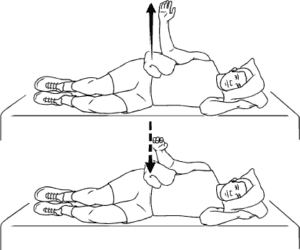
Assisted pull-up
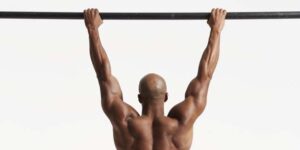
- How to do this strengthening exercise:
- This is a very effective exercise motion, but most individuals do not have the upper limb strength to perform one without a little help.
- This motion works not only on the posterior deltoids but also work on the lattisimus dorsi, trapezius, and biceps as well.
- Adapt the weight determination on the side of the machine. Choose the correct amount & set. Climb onto the knee pad & push it down until it is low enough for the patient to place both knees on.
- Keep the knees up to hip-width apart. Hold the outer handles above you, the palms should be facing away from the center.
- Straighten the arms & lower yourself to the starting position. Pull the body up until the chin is level with or above the handles.
- Keep the position for a couple of seconds, after that lower yourself down with control.
- Focus on keeping the shoulder blades contracted. They should be pressed back & down.
- Start with ten to twenty repetitions & work up to ten repetitions.
Barbell upright row
- How to do this strengthening exercise:
- The barbell upright row works the anterior & middle heads of the deltoids.
- For this exercise, the patient has to Stand with the shoulder- feet width apart. Then, grab the barbell & allow this to hang in front of you at the length of the arms. Keep the palms facing the body & the hands in line with the thighs.
- Inhale & brace the abdominals. The back should be straight, chest up, & eyes focused forward.
- Raise a bar directly up (toward the chin) with the breath out.
- Guide with the elbows & hold the barbell close to the body.
- The arms should go no higher than the shoulder’s height; slightly less is okay.
- Keep at the top of the lift for one to two seconds.
- Lower the bar as you breathe in, coming back to the starting position.
- Do ten to fifteen repetitions of one to two sets.
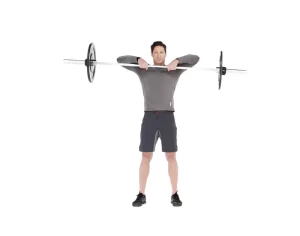
When did the patient not do the Deltoid strengthening exercise?
- If the patient is already suffering from shoulder pain then he should avoid this exercise.
- If the doctor advised the patient to take rest.
- If the arm bone is recently fractured.
- If the patient has back pain then avoid weight-lifting exercises.
- If the patient feels any shoulder pain or even discomfort while this exercise.
FAQ
Weakness of the shoulder may come from deficits in the coordination of nerve muscles or even tendons. Often weak shoulders will respond to the gradually progressive strengthening program. If shoulder weakness does not respond to these exercises this may be owing to a rotor cuff issue or a nerve injury.
The patient uses them to raise the hand, reach out to lift the toddler, swing the arm back to serve the tennis ball & hold himself up in plank position. Exercising the front delts will tone & strengthen the shoulders as well as protect the range of movement the patient need for sports & daily activities.
Small or even partial deltoid muscle injuries can be treated conservatively with shoulder movement, stretching exercises, & gradual strengthening. These can be done with the assistance of a therapist or an athletic trainer. Treatment of larger & complete tears requires surgical exploration and repair as well.
Sometimes the patient may just have been doing more than the shoulder is used to doing (overloading) or the muscles can be weaker & underused, all of which can lead to pain & loss of motion. However, lifestyle factors such as being overweight, unfit, or even smoking have all been linked to tendon problems & shoulder pain.
Lateral raises using the resistance band may strengthen the shoulder after the deltoid injury. Wrap one end of the resistance band around the left foot & hold the other end in the right hand to strengthen a right-hand deltoid injury, reverse the directions to strengthen the left deltoid.



